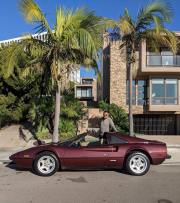Pilota, January-February 2022 issue
We know the Ferrari 308 as the iconic car driven by the tall, handsome Tom Selleck played on TV as Magnum PI. But, what do we know about this car?
At one time or another, Magnum indeed drove a 308 QV, meaning a 308 with four valves – quattrovalvole in Italian – instead of two for each of its eight cylinders. The news here is that the 308 QV model Ferrari had so much more going for it than four valves per cylinder for the guys and a good looking guy for the gals.
Those four valves per cylinder signaled the evolution of Ferrari’s fuel delivery systems compliant with emissions controls in the U.S. and extracted more power from the engine. Concurrent increases in stability made the 308 unable to spin out on pavement, a result requiring Magnum to do his spinning on green grass made slippery to dramatize the newfound oomph of the 4-valved 308. Hollywood has its own requirements for showing power.
Ferrari 308 also introduced the iconic removable hard top. Lore has it that the 308 always showed on Magnum PI episodes with the top off, owing to Selleck’s inability to fit in the Ferrari with the top on and pedals positioned off to the right. After all, the 308 is a small sports car, lower than others, and “not for the faint-hearted nor for the stiff-jointed,” according to San Diego Ferrari Owners Club member, Sanjeev Thohan, about his 1985 308 QV.
As the owner of the classic QV, Sanjeev goes on to opine that every Ferrari has a ‘personality’ attentive to its characteristic build quality. He explains Ferrari not as a production car but a bespoke automobile for the designer to build nuances into the car that define — if not purposefully accentuate — its unique personality. Sanjeev further explains that his 308 QV is not as fast as current cars but that it’s not just about power. “It’s style and power. It’s an assurance. It’s a visceral experience with the gated gear shifter integrating with the clutch and accelerator, accompanied by sound coursing through the gears, all to yield a smile of satisfaction and pure joy as the look on the face of the Ferrari owner.” Sounds like poetry, doesn’t it?
Poetic license allows an owner to describe the 308’s driving experience as oneness with the road, a bond, a connection between car, driver, and the solid pavement below both of them. Sanjeev opines that modern technological advancements lack the same connectivity among those elements so delivered in the 308 QV. Although that statement stands as opinion, drivers of more technologically advanced Ferraris often nod in agreement. Besides, Sanjeev always sports a huge smile while driving his 308 QV.
Sanjeev speaks with a smile also of Ferraris emerging from Enzo’s early visions but with a modern twist. That twist has to do with the era of curvaceous beauties appearing in Hollywood at the time. “Kim Bassinger comes to mind,” when speaking of his first hunt for a Ferrari, none of which he found or could afford. “Left to dreams” is how he describes his early days looking for an affordable Ferrari, which took him through several possibilities including the F430 manual, the 360 manual, eventually landing on the 308 QV (also a manual) found in our back yard of San Diego by a friend on Long Island, New York. As Sanjeev says, “network means everything when searching bespoke Ferraris.”
Sanjeev looked at it, liked it, drove it, thinking it “amazingly tactile” in his mind primed with dreamy Hollywood imagery but actually arising from everything in the 308 QV being manual rather than powered…or so he says. (Authors note: Ladies know that line as what guys say out loud rather than say what’s really in their minds while driving a Ferrari.)
For its mystery, lore, instant recognition, and fame, the 308 QV remains a living icon of an era that still lusts for attention…and gets plenty of it when spotted by Ferrari fans on the road. For the tifosi in the know and for the Ferraristi who know its nature innately, the 308 QV will forever remain an icon here in America with its proud owner right here in the Club.
Article and photography by Lorraine Yapps Cohen







